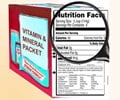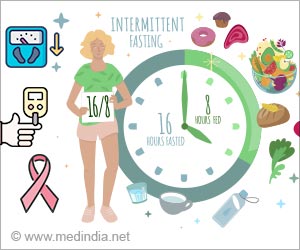New study has examined the impact of moving nutrition labels, typically placed on the back of product packages, to the front.

‘Front-of-Package (FOP) nutrition labels are voluntarily adopted by food manufacturers and provide nutrient information on the front of food packaging in a clear, simple, and easy-to-read format.’





Can changing food packaging improve product nutrition quality? While this change may be simple, there's a lot at stake. Diet-related chronic diseases impose a growing burden on the United States economy by increasing costs of health care and widening diet-related health disparities. Since the 1970s, the American diet has shifted considerably towards foods higher in calories and lower in nutritional quality. According to the Centers for Disease Control and Prevention estimates, more than one-third of American adults are obese.
Childhood and adolescent obesity rates have also skyrocketed in the last 30 years with one in five school-aged children considered obese. To combat this disconcerting trend, public policy makers, food manufacturers, and grocery retailers have made efforts over time to design nutrition labels that can educate consumers about the nutritional value of the foods they purchase and help consumers make healthier choices. The World Health Organization (WHO) also considers nutrition labeling to be a key policy option for promoting healthier diets.
The packaged food industry has voluntarily taken steps to inform consumers about the nutritional value of food products so that consumers can make better choices. One such initiative undertaken by is the Front-of-Package (FOP) nutrition label.
The FOP labels present the key information listed on the Nutrition Facts Panel (NFP; displayed on the back or side of food packages) more concisely and often include calorie content and the amounts of key nutrients to limit (e.g., saturated fat, sugar, and sodium per serving).
Advertisement
The study reports four sets of findings. First, the adoption of FOP nutrition labeling in a product category results in a significant improvement in the nutritional quality of food products in that category. Second, the effect of FOP is stronger for premium (high-priced) brands and brands with a narrower product line breadth.
Advertisement
Lim explains that "This implies that policy makers, in partnership with food manufacturers and retailers, should encourage adoption of voluntary, standardized, and transparent labeling programs and consider options for broadening the information presented in FOP labels. We believe that policy makers should also invest in educational campaigns that inform consumers about the value of FOP labels and that would further incentivize food manufacturers to offer nutritionally better products."
For food manufacturers, the results suggest that they must devote significant resources to product innovation to stay competitive. Specifically, manufacturers in unhealthy and more competitive categories can be more strategic and invest in innovation so they are ready to provide better products following FOP adoption.
Rishika adds that "Food retailers should partner with manufacturers and give them incentives to adopt FOP because this can lead to better-quality products for their consumers and help build a positive brand image. Retailers can also promote products with FOP labels, especially in more competitive and unhealthy product categories, which can spur manufacturers toward more innovation and lead to an increase in the nutritional quality of foods over time."
The researchers encourage retailers to invest in measures that help monitor and track sales of products with FOP labels and provide this feedback to their manufacturers regularly to speed up the competitive effect of FOP labels.
For consumers, the study finds that the brands that adopted FOP labeling offer nutritionally superior products than those that did not adopt the labeling. This result is particularly helpful for time-starved consumers looking to purchase relatively healthier products.
Source-Eurekalert













